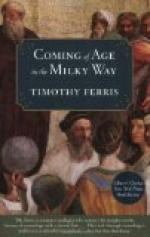
|
| Name: _________________________ | Period: ___________________ |
This test consists of 5 multiple choice questions, 5 short answer questions, and 10 short essay questions.
Multiple Choice Questions
1. What is the religious belief that humanity, life, the Earth, and the universe are the creation of a supernatural being, most often referring to the Abrahamic God?
(a) Creationism.
(b) Asceticism.
(c) Heliocentricism.
(d) Triangulation.
2. What are fuzzy patches of glowing material that can be observed throughout the universe?
(a) Nebulae.
(b) Particles.
(c) Leptons.
(d) Bosons.
3. What does SETI stand for?
(a) Search for extraterrestrial intelligence.
(b) Stationary energy transmission intelligence.
(c) Static energy for transintelligence.
(d) Satellite for elliptical integers.
4. Who wrote, "The greatest of all the accomplishments of twentieth-century science has been the discovery of human ignorance"?
(a) James Williams.
(b) Lew Thomas.
(c) Giuseppe Cocconi.
(d) Philip Morrison.
5. What Russian scientist theorized that the beginning of the universe may have started with a core so hot and dense that it created nuclear fusion and created the elements now known to man?
(a) Claudius Ptolemy.
(b) George Gamow.
(c) Edwin Hubble.
(d) Fred Hoyle.
Short Answer Questions
1. Who discovered the period-luminosity phenomena that enabled the distances of the Milky Way and objects in deep space to be measured?
2. When was Albert Einstein born?
3. The first step in the exploration of intergalactic space was taken by what philosopher?
4. Where was Albert Einstein born?
5. Who wrote in fourth century BC that "to consider the earth as the only populated world in infinite space is as absurd as to assert that in an entire field sown with millet only one grain will grow"?
Short Essay Questions
1. How have advancements in the sciences improved mankind, according to the author in Chapter 19: "Mind and Matter"?
2. What was indicated by Einstein's theory of relativity, according to the author in Chapter 11: "The Expansion of the Universe"?
3. What discoveries does the author describe regarding spiral nebulae in Chapter 9: "Island Universes"?
4. What influenced Emmanuel Kant in his interest in cosmology according to the author in Chapter 8: "Deep Space"?
5. What were the strengths of Darwin's "The Origin of the Species," according to the author in Chapter 14: "The Evolution of Atoms and Stars"?
6. What three basic areas of study relative to the expansion of the universe does the author describe in Chapter 12: "Sermons in Stones"?
7. What advancements led to the discovery of the composition of the stars, according to the author in Chapter 10: "Einstein's Sky"?
8. What was theorized in a paper written by Vesto Slipher in the early 20th century, according to the author in Chapter 11: "The Expansion of the Universe"?
9. What obstacles did early quantum physicists have, as described by the author in Chapter 15: "The Quantum and its Discontents"?
10. How does the author compare telescopes and accelerators in Chapter 17: "The Axis of History"?
|
This section contains 983 words (approx. 4 pages at 300 words per page) |

|




